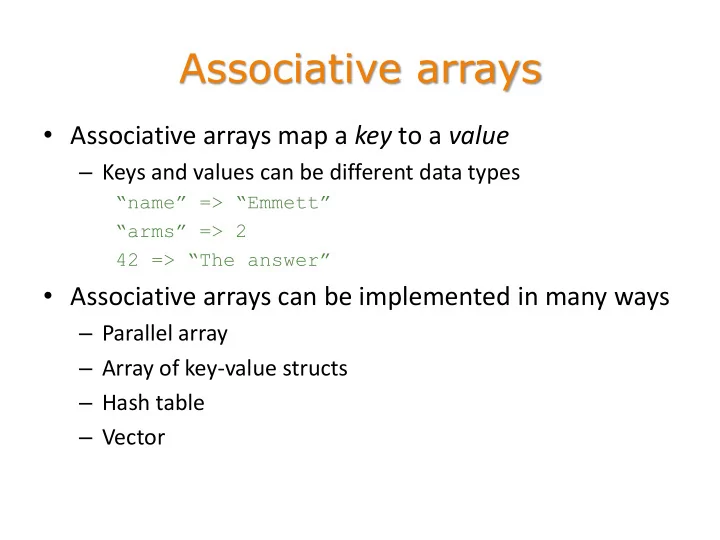

Associative arrays • Associative arrays map a key to a value – Keys and values can be different data types “name” => “Emmett” “arms” => 2 42 => “The answer” • Associative arrays can be implemented in many ways – Parallel array – Array of key-value structs – Hash table – Vector
Ordered maps • PHP implements associative arrays as ordered maps – The key-value pairs are stored in a particular sequence • Standard array-subscript notation is typically used – With keys instead of integer indeces – Supports both assignment and retrieval $a [“ key_one ”] = 72; print $a[“ key_one ”]; – Setting the value for a non-existent key creates the key- value pair $a[“ newkey ”] = 7; – Retrieving the value for a non-existent key returns NULL ($a[“ newkey ”] == NULL) # is TRUE
Iterating over associative arrays • Unless the keys are contiguous integers (0,1,2,3…), a standard for- loop doesn’t make sense – It will just return NULL for all the non-existent keys for( $i=0; $i<count($a); $i++ ) { print “<h1>$a[$ i]</h1>\ n”; }
Iterating over associative arrays • Instead, like many scripting languages, PHP has a convenient foreach loop – Iterates over the array values in order – Loop syntax specifies: • The array to iterate over ($myarr) • A variable name to bind each successive value to ($a) foreach( $myarr as $a ) { print “<h1>$a</h1> \ n”; }
Iterating over associative arrays • Foreach can also iterate over the keys and values – Syntax specifies variables to bind each key and value foreach( $myarr as $k => $v ) { print “< li>Key: $k, Value: $v\ n”; }
Simulating indexed arrays • Associative arrays can always be used like indexed arrays – Simply use contiguous integers as keys • PHP provides shortcut appending with an empty subscript $arr = array( “a”, “b”, “c” ); # keys 0, 1, 2 $arr [] = “d”; # “d” has key 3
Keys and values • Retrieve the keys from an array array_keys( $a ); – The keys are returned as an array with indeces 0,1,2… • Retrieve the values from an array array_values( $a ); – The values are returned as an array with indeces 0,1,2…
Removing array items • Setting a key to the value NULL… $a[“name”] = NULL; – Is kind of like removing it: print $a[“name”]; # prints NULL – But not really: array_keys( $a ); # still one of the keys count( $a ); # still counted • The unset() function deletes variables unset( $myVar ); – Including key-value pairs in an array unset( $a[“name”] );
Recommend
More recommend